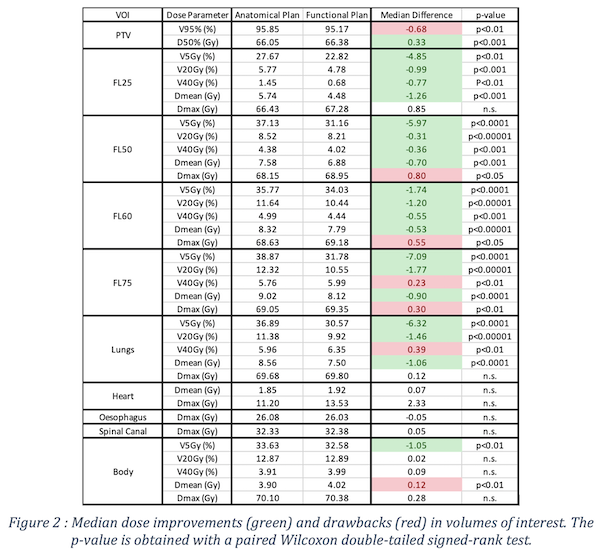Functionality-optimised radiotherapy for lung cancer patients using 4DCT
PD-0156
Abstract
Functionality-optimised radiotherapy for lung cancer patients using 4DCT
Authors: Aurélian Quinet1,2, Zelda Paquier2, Younes Jourani2, Patricia Fernandes2, Paul Van Houtte3, Dirk Van Geestel3, Nick Reynaert2
1Pôle Hospitalier Jolimont, Medical Physics, Haine-Saint-Paul, Belgium; 2Institut Jules Bordet - Université Libre de Bruxelles, Medical Physics, Brussels, Belgium; 3Institut Jules Bordet - Université Libre de Bruxelles, Radiation Oncology, Brussels, Belgium
Show Affiliations
Hide Affiliations
Purpose or Objective
The risk of Radiation-Induced Lung Injuries (RILI) is directly related to the volume of functional lung receiving at least 20 Gy (V20Gy) and to its mean dose (Dmean). Reducing these doses by implementing functional lung imaging in radiotherapy (RT) treatment planning could reduce the risks of RILI. The aim of this study is to retrospectively investigate the feasibility of 4DCT-based functional RT treatment planning for thoracic tumors using available clinical tools.
Material and Methods
20 selected patients underwent a 4DCT (Aquilion LB, Canon Medical Systems Europe B.V., Zoetermeer, The Netherlands) for a thoracic RT treatment between July and October 2020. Peak Inhalation (PI) and Peak Exhalation (PE) 4DCT images were used to calculate ventilation via the Jacobian method using the default intensity-based free-form deformable image registration on MIM Maestro (v7.0.6, MIM Software Inc., Cleveland, USA). Functional lung contours FL75, FL60, FL50 and FL25 were segmented by thresholding the ventilation distribution at the 25th, 40th, 50th and 75th percentiles, respectively, then transferred on the initial planning CT with a rigid registration of the PI image. Two Monaco (v5.51, Elekta AB., Stockholm, Sweden) VMAT plans were optimized for each patient with a 33x2 Gy prescription: one anatomical plan using classical constraints and one functional plan with ALARA constraints on V20Gy and Dmean for FL60 and FL25. Intra-method distinctness of functional volumes was assessed using a Kruskal-Wallis test. Dose improvements were assessed using a paired Wilcoxon double-tailed signed-rank test. Functional volumes and dose differences were compared with our previous work based on SPECT. A p<0.05 significance level was used for each test.
Results
The Jacobian method provided 4 distinct (p<0.001) volumes (Figure 1) larger than their perfusion SPECT counterparts (p<0.00001).

DVHs showed a reduction in almost all doses for functional lung contours, anatomical lung and the body, with no substantial change in the dose to the target and organs at risk. Results (Figure 2) show a reduction of median V5Gy, V20Gy and Dmean in all lung volumes (p<0.01). However, median V40Gyincreased in FL75, anatomical lungs and body (p<0.01). Small changes were found for the PTV dose coverage, although all constraints were met. No significant changes were observed in doses to the heart, esophagus, and spinal canal. Good agreement was found with our SPECT-based study regarding the impact of functional planning.

Conclusion
The 4DCT-based Jacobian ventilation method was successfully implemented using clinical tools while delivering promising results regarding functional lung avoidance to mitigate RILI. All results were consistent with the literature. Future work should concentrate on improving the implementation of 4DCT ventilation in the RT planning workflow and investigating functional planning at a larger scale. This opens the way for prospective functional lung avoidance studies.